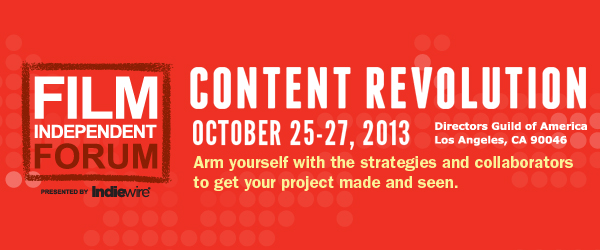How Case Studies Can Change Your Life — Or At Least Make You a Smarter Filmmaker

Case studies make for a great, up-to-date textbook on filmmaking. They’re detailed analyses of filmmakers’ current practices for financing, producing and distributing their films. And they’re a valuable part of our annual Filmmaker Forum (October 25-27, 2013) education conference, which starts pre-sale to Members today.
Since the first Film Independent Forum in 2005, each year from the end of summer to mid fall, we talk to filmmakers who have released their films in the last year or so. Each year we select up to 20 of the films to highlight that have gone through the festival circuit and into distribution outlets. From these candid interviews we have published more than 100 case studies over the last eight years. Looking at them in hindsight, it’s like watching the recent history of independent film unfold as technology offered new tools, not only for production, but for distribution.
We have come a long way. When we started collecting case studies, YouTube was in its infancy and very few filmmakers were beginning to set up websites to promote their films. In 2005, for the first Forum, trying to offer a view into the “future,” we assembled with distribution expert Peter Broderick a group of filmmakers with “obscure” niche films who were beginning to exploit the rights of their films directly through their own websites with some success. This was just a taste of the social media revolution that was about to hit us, and that has forever changed the landscape of distribution, offering filmmakers the tools to play on a more level playing field. Filmmakers reaching their audiences directly through their own means is no longer a novelty, but has now become standard practice. The industry has evolved – from a monolithic distribution business model to a more entrepreneurial open system that allows filmmakers to split rights and pursue a variety of distribution venues.
For the upcoming 2013 Forum, we will add another 15 or 20 case studies on select films released over the past year to the collection. The new studies will be published as a hand-out for all Forum attendees, and many of the filmmakers will be in attendance to expand in off the record sessions on their case studies. Older studies are available on our website. Each year’s collection provides a snapshot of the independent film landscape of the prior year. Last year we covered 20 films made for $45 million–that’s 20 unique, compelling stories that were made for the price of the average marketing budget of a single Hollywood film.
“There is a lesson in each an every one of these case studies, and it is not necessarily the same lesson,” says Paul Cowling, Film Independent’s Associate Director of Film Education, who’s also the producer of the case studies. By examining each year’s batch of case studies, you can find find the most up-to-date lessons that apply to you, looking closely for the ways, means, people, festivals, producers reps, publicists, distributors involved in each process. Here’s a recap of some of the trends from last year’s Forum case studies:
There are many alternatives to equity financing.
While equity financing continues to be the most common source of financing, a considerable number of films were made with the support of multiple film arts organizations, subject-specific grants, and foundations that are increasing their support for socially relevant films with difficult subject matter. Films like Pariah, Bully, Circumstance, The Invisible War and Better this World to name just a few, would have not been possible without the support of these organizations. Other films broke records on crowdsourcing sites, such as Kickstarter and IndieGoGo, with first-time filmmaker Aurora Guerrero’s Mosquita y Mari raising over $80,000 (in spite of everyone, including the Kickstarter folks, telling her that that was too high of a goal). Just one year after Guerrero’s feat, breaking the six-figure mark in a Kickstarter campaign for a film has now become commonplace.
The gospel of hybrid distribution has taken effect.
Of the 20 films featured in 2012, ten signed a traditional distribution deal with one of the mini major distributors (The Weinstein Co., Roadside Attractions, Focus Features, Fox Searchlight, Open Road). The rest split their rights in varying degrees, from sharing their domestic theatrical release with a distributor like Participant Films as Ava DuVernay did for her theatrical release of Middle of Nowhere, while choosing to exploit the rest of the rights through her own distribution company AFFRM; to carving out theatrical, cable, public television, DVD, VOD, educational rights and splitting them amongst different buyers, platforms and territories.
VOD is here to stay.
A major milestone in the VOD day-and-date model was established when Margin Call, from first-time director J.C. Chandor, became the first VOD/Theatrical Day & Date success story, with a final box office of just over $5.3 million and grossing well over $15 million, making it one of Lionsgate’s most profitable films of that year. Domestic grosses across all platforms (iTunes, Amazon, hotels, Xbox) had exceeded $20 million by the Fall off 2012 Although at the time of our case study they were beginning to see profit payments from Roadside/Lionsgate, the filmmakers still weren’t clear on how it all broke down.
Join us at the 2013 Forum for this year’s reports from the trenches of filmmaking.
By Maria Raquel Bozzi / Director of Education